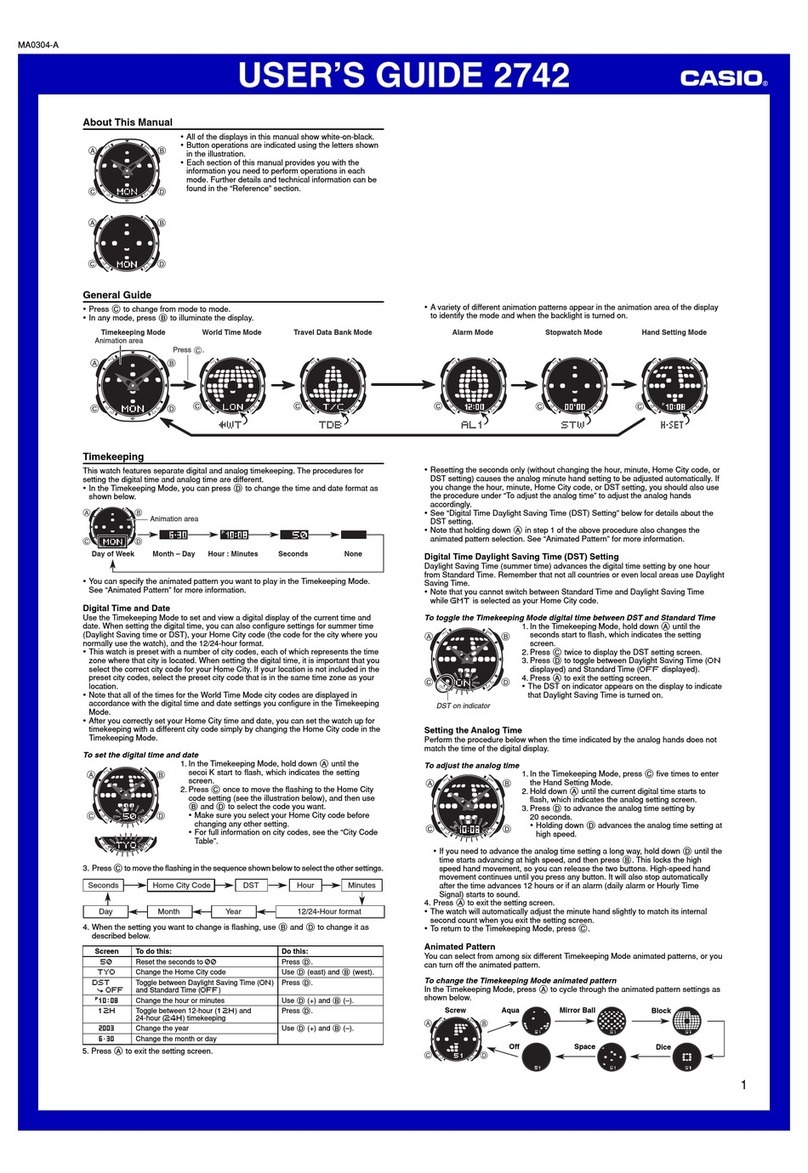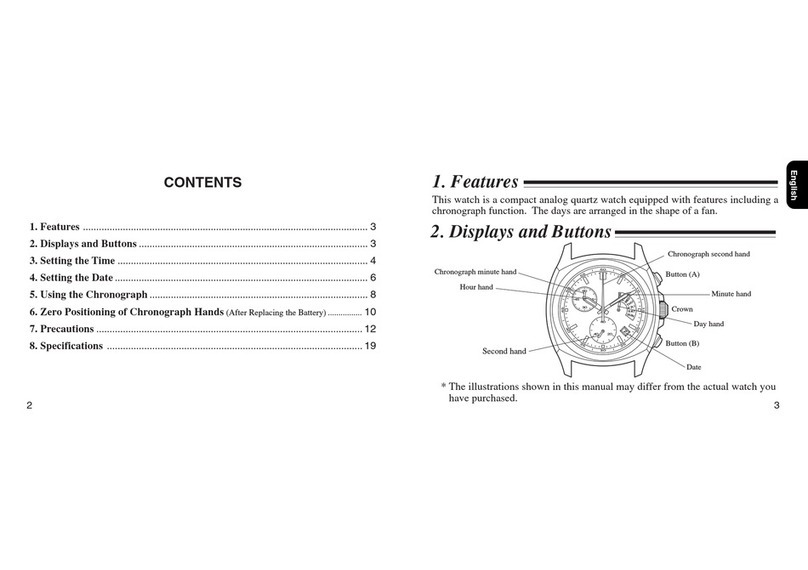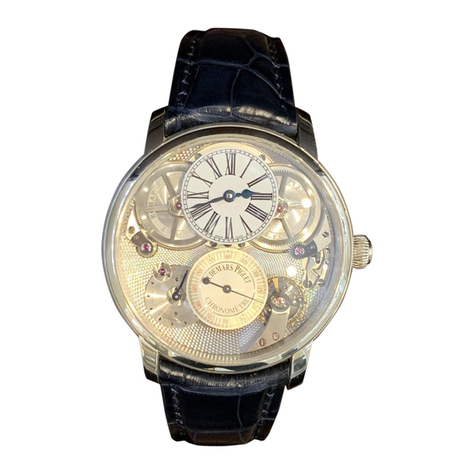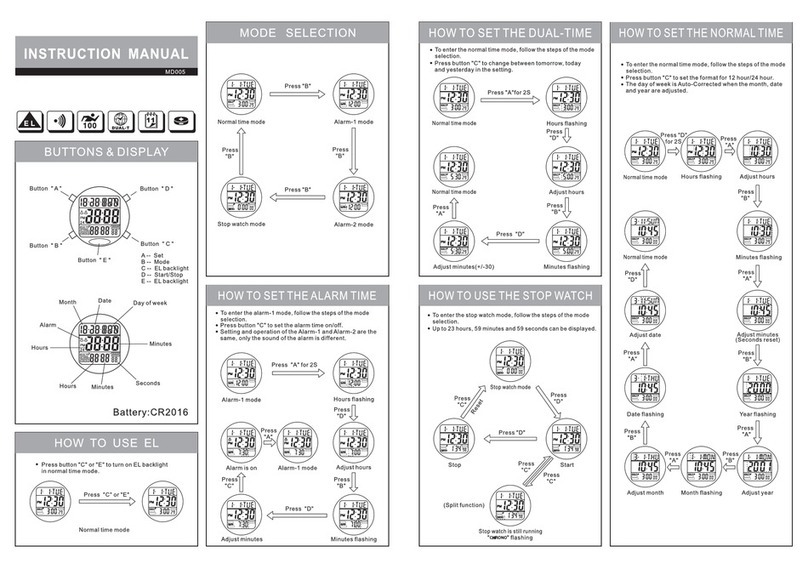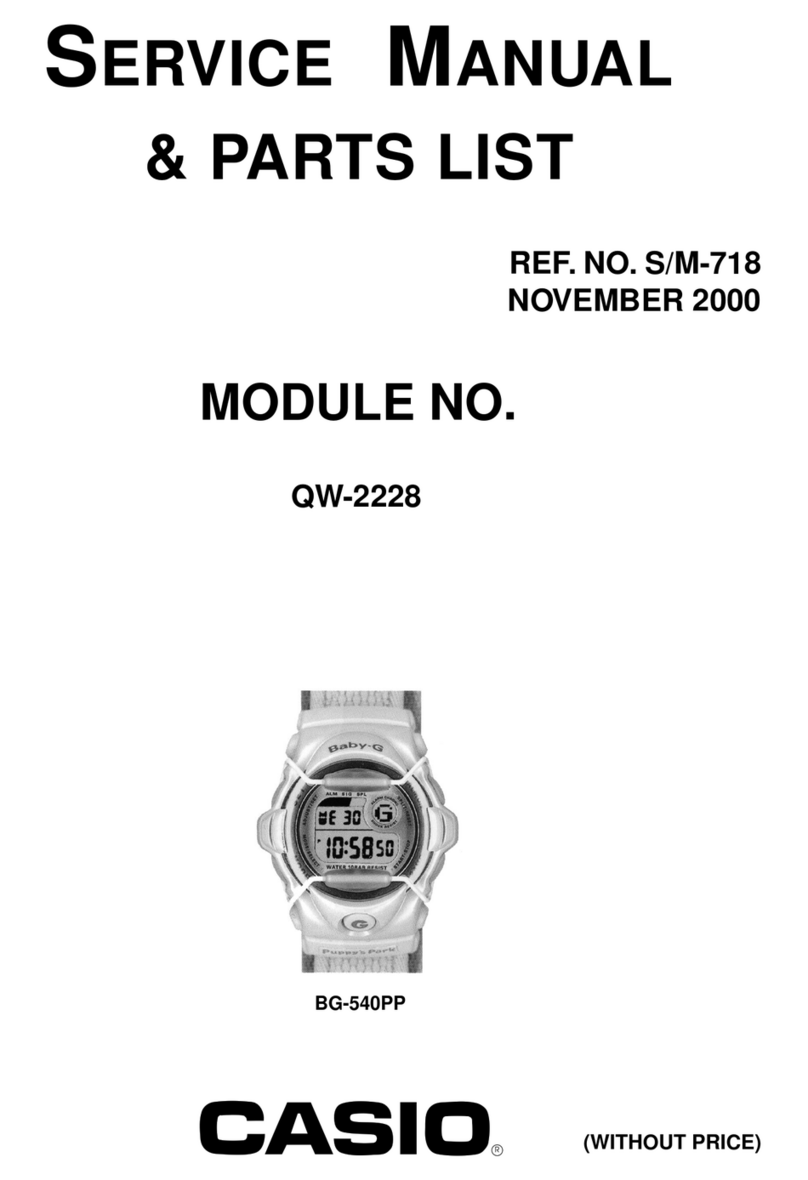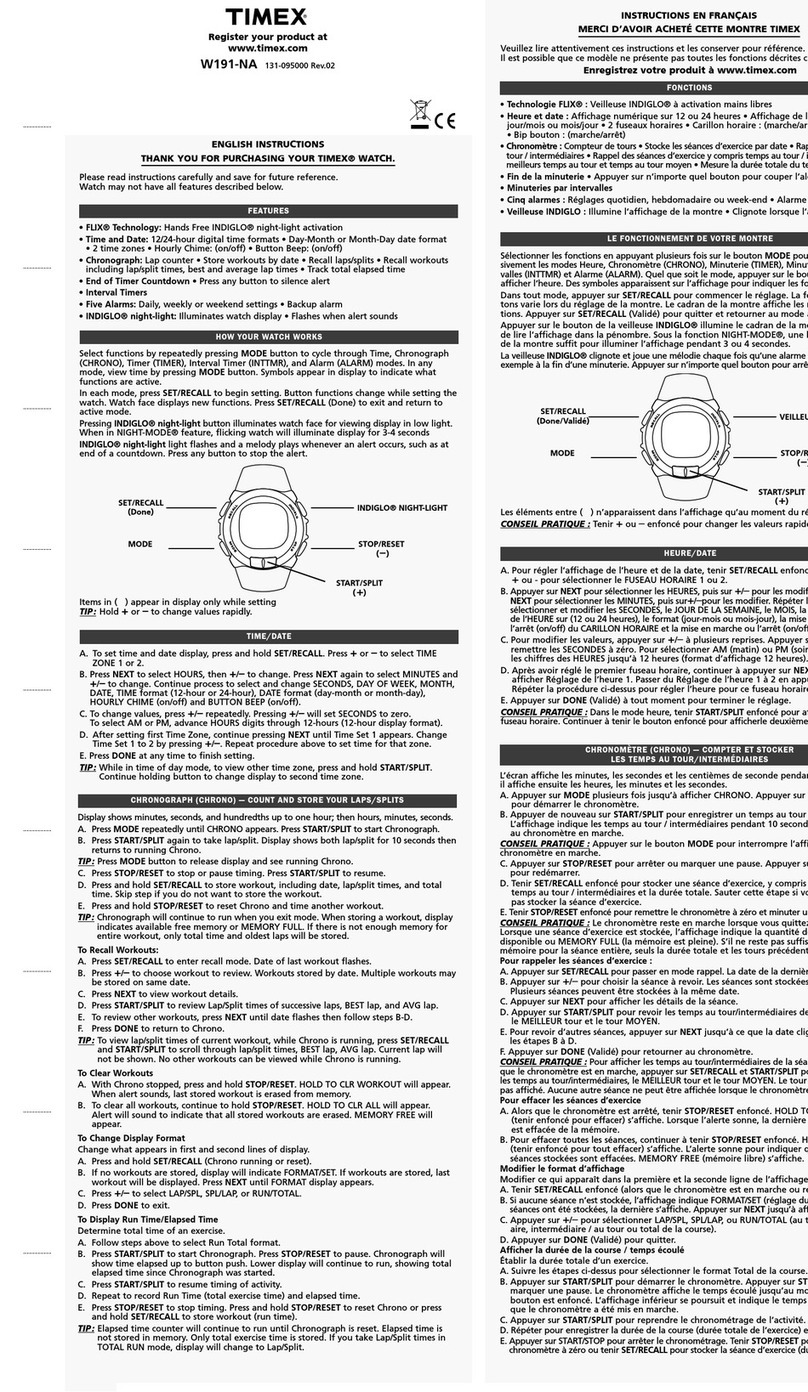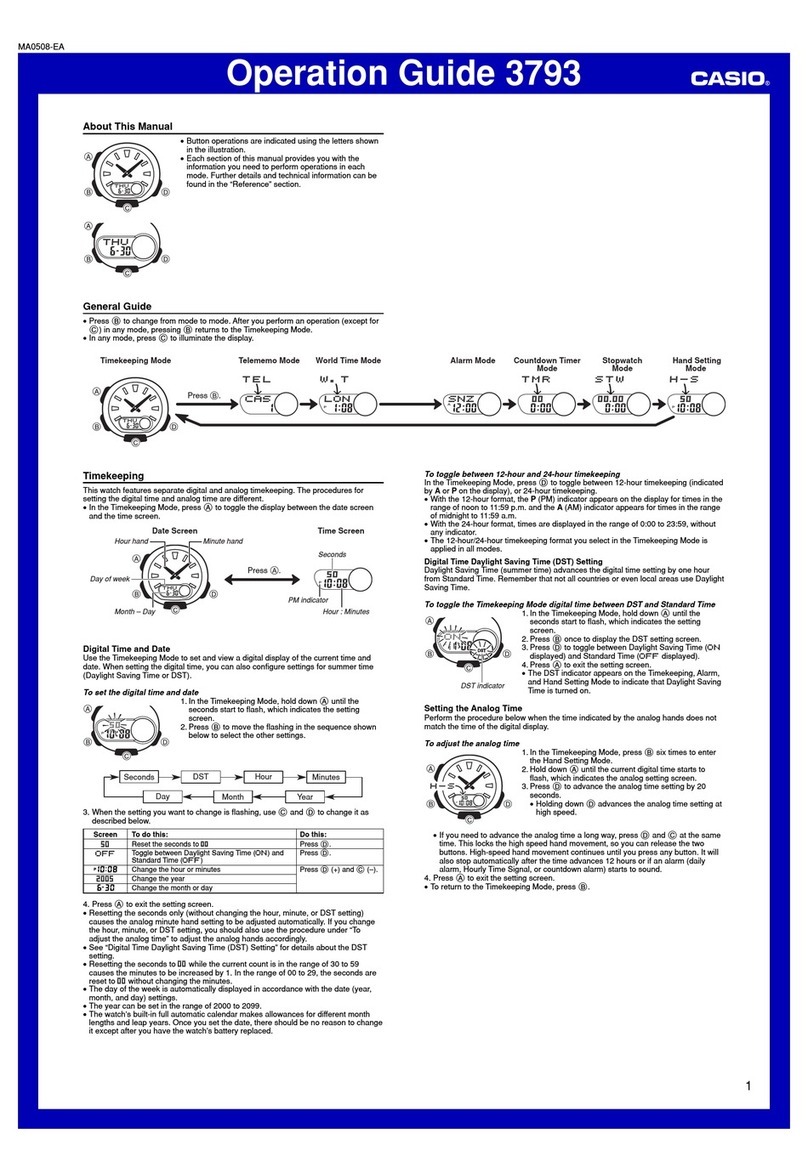Jean Dunand Shabaka User manual

SHABAKA
CALIBRE CLA88QPRM BY CHRISTOPHE CLARET
OWNER’S MANUAL

Pushpiece to set the month and the year
(set into the crown)
Winding and setting crown
Pusher B: to advance the entire calendar
(one day at a time)
Pushpiece to set the moon
(set into the case)
Moon phases
Leap-year cycle indicator
Slide to activate the minute-repeater
Hammer striking the minutes
Hammer striking the hours
Dates cylinders
Days cylinder
Months cylinder
Hours hand
Minutes hand
Pusher A: to set the day
Cathedral gongs
State-of-wind indicator
Safety catch for pusher A
Safety catch for pusher B
2

1. WINDING
Your Shabaka watch has a manually wound movement. Wind the
watch by turning the crown forward. The winding mechanism
is disengaged if the crown is turned back. Stop winding if you feel
any resistance, this is the sign that your watch is fully wound.
When it is fully wound, your watch will have a power-reserve of
approximately 45 hours. If you are not wearing your watch, you can
keep it wound by connecting it to the electric winding motor in its
presentation case. See page 7 for instructions.
2. SETTING THE TIME
Warning! Do not change the time on your watch while
the minute-repeater is chiming. Doing so will damage the
movement. To set the time, pull out the crown to the time-setting
position. Turn the crown backward only to advance the hands.
First, set your watch to the morning or the afternoon (a.m. or p.m.) by
advancing the hands past 12 o’clock. If the date changes, the hands
have passed midnight and the time shown is a.m. If the date does
not change, the hands have passed noon and the time shown is
p.m. Advance the hands to the correct time in the morning or the
afternoon. Then, push the crown back against the case when you
have finished setting the time. If necessar y, reset the date by using
the pushers described in section 3.
3

3. SETTING THE PERPETUAL CALENDAR
3.1 SETTING THE DATE
Start by unlocking pusher B by opening its safety catch beneath
the watch. Press pusher B to advance the calendar a day at a time
until the correct date is shown (ignore the fact that the days cylinder
is turning during this operation). After setting the date, lock pusher
B by closing its safety catch . If the day or month does not correspond
to the date, they can be set separately by following the instructions
3.2 and 3.3.
You will be unable to set the date to the 31st of the month unless
the month shown on the watch has 31 days. In that case, set the correct
month first, according to the instructions 3.3; then set the date.
The moon phase is set independently of the date (see section 3.4).
3.2 SETTING THE DAY
Unlock pusher A by opening its safety catch beneath the watch.
Press pusher A to advance the days cylinder a day at a time until the
correct day appears. Then, lock pusher A after use by closing its
safety catch .
Warning! Pressing pushers A and B when they are locked may
damage your watch.
4
B
A

3.3 SETTING THE MONTH AND THE YEAR
First, determine the status of the year in the leap-year cycle (leap
year or the 1st, 2nd or 3rd year). Use the stylus provided in the
presentation case to press the pushpiece set into the crown of the
watch. This advances the months as well as the year indicator when
the months pass December. If necessary, press the pushpiece until
the year indicator changes to the correct year in the leap-year cycle:
B (leap year/bissextile), 1, 2 or 3. Then continue to press the push-
piece until the right month appears.
The calendar is now set to indicate February 29 every leap year.
Caution! If you go too far and pass the desired month, you will have
to press the push-piece up to 47 times to advance through the
four-year cycle to the right month and year.
3.4 SETTING THE MOON PHASE
First, consult a calendar or almanac to determine the number of
days since the last full moon. Using the stylus provided in the
presentation case, press on the push-piece as indicated to advance
the moon until it appears full in its aperture. Continue to press the
pushpiece once for each day since the last full moon in the calendar.
Your watch is now set to show the changing phases of the real moon.
Leap years: Every four years, an extra day (February 29) is added to the year to make
up for the fact that the annual orbit of the earth (the tropical year) takes about 365 ¼
days. Leap years, with 366 days, are generally divisible by four. Thus 2008, 2012, 2016,
2020, etc. are leap years.
Indications corresponding to the leap-year cycle
2008 2009 2010 2011 2012
5

The minutes hammer and the hours hammer
The gong for the minutes and the gong for the hours
4. STATE-OF-WIND INDICATOR
The mainspring, visible in its barrel through the back of the watch,
shows if your watch needs winding.
5. MINUTE-REPEATER
The minute-repeater strikes the hours, quarters (15mins) and minutes
on demand. Two hammers each strike a corresponding gong to
produce two different notes for the hours and minutes. The two gongs,
consisting of tuned rods coiled twice around the movement, are known
as “cathedral gongs”.
One hammer strikes deep notes for the hours.
The other hammer strikes high notes for the minutes.
The hammers strike a high and a deep note in quick succession
for each quarter.
Example: the chiming sequence at 05:18
The hours hammer strikes five deep notes; both hammers then
produce a double strike (high note, deep note) for the quarter;
finally, the minutes gong strikes three times to indicate the number
of minutes since the quarter.
To activate the minute-repeater, push the repeater slide down carefully
until it stops, and then release it immediately. It is important to
push the slide the full length of its travel so as to wind the repeating
mechanism fully. An all-or-nothing device prevents the repeater
chiming unless it is fully wound.
Warning! Do not set the time while the minute-repeater
is chiming. Doing so will damage your watch.
When your watch is fully wound, the mainspring appears
tight around the center of the barrel.
As the spring unwinds, it comes against the rim of the barrel,
indicating that the power reserve is low.
Hours Quarters Minutes
6

PRESENTATION CASE WITH ELECTRIC WINDER
AND SOUNDBOARD
The presentation case of your watch is fitted with a tray in Macassar
ebony holding a winding motor designed to be used only with the
Jean Dunand Shabaka watch (calibre CLA88QPRM).
A soundboard crafted from spruce according to violin-making
techniques is also fixed on the tray to provide a natural amplifier for
the chime of the minute-repeater. With the watch held securely in its
mounting, you can activate the minute-repeater to appreciate fully
the sound of its strike. You will also find a stylus to press the push-
pieces that set the months and moon phases, as well as a lens with
which to examine the intricacies of the mechanisms. The tray and its
contents can be removed gently from the case.
Warning! Only use the winding motor for your Jean Dunand Shabaka
model. It will damage the movement of any other watch.
FITTING THE WATCH TO THE WINDING SYSTEM
First check that the crown is in the winding position, pushed against
the case. Place the watch carefully between the four pegs that hold
it in place, with the crown facing the winding motor.
WINDING SYSTEM OPERATION
Start winding by pushing the start/stop lever clockwise as far as it
will go. The winding mechanism engages with the winding crown on
the watch. The motor checks the contact with a back and forth
movement and then proceeds to wind the watch fully. Without any
further intervention, the motor rewinds the watch fully every 10 hours.
This means that the watch will always have a minimum of about
35 hours power reserve, with its full power reserve being about
45 hours. To switch off the winding operation, move the lever back
to the Stop position.
Stylus Start/stop
lever
Watchmaker’s lens
Tray
Soundboard
Electric
winding
motor
Watch holder
Start
Stop
7

REMOVING THE WATCH
Warning! To remove your watch from the winder, move the lever to
the Stop position and ensure that the mechanism is disengaged from
the winding crown.
If you want your watch to be fully wound before removing it, shift
the lever to Stop and then to Start. It will then take about 30 seconds
to wind your watch fully. Don’t forget to move the lever to Stop
before attempting to remove your watch.
WINDING SYSTEM BATTERIES
The winding motor is powered by two 1.5V LR14 batteries (Type C).
They last for about a year. When their power is low, a light comes
on above the Start/Stop lever at the back of the winding motor.
The batteries should then be replaced as soon as possible and within
a month. Therefore, it is important to check the batteries
every month.
CHANGING THE WINDING SYSTEM BATTERIES
Warning! Remove your watch from the soundboard before changing
the batteries. Place the tray on its end to access its underside. Unscrew
the two caps of the battery housings. Replace the used batteries,
making sure that the new batteries are inserted the correct way with
the + against the caps. Screw back the caps and lay the tray flat.
TAKING CARE OF YOUR WATCH
The Shabaka watch is designed for daily wear and to run
continuously. However, it is not suitable for any activity that might
subject it to violent shocks.Like any high-precision machinery, the
movement of the watch needs regular cleaning, oiling and adjusting.
We recommend you have it serviced every three years to ensure its
indefinite operation and lasting value.
The Shabaka watch can only be serviced or repaired in the workshops
of Christophe Claret SA. Intervention on the watch by any other
person will invalidate Jean Dunand’s guarantee.
If your watch needs service or repair, please return it to the
authorized retailer where you bought it or to WPW S.A. in Geneva,
with its valid warranty certificate. If you send your watch by post
or courier, please ensure it is securely packaged, fully insured,
and accompanied by its warranty certificate.
8
